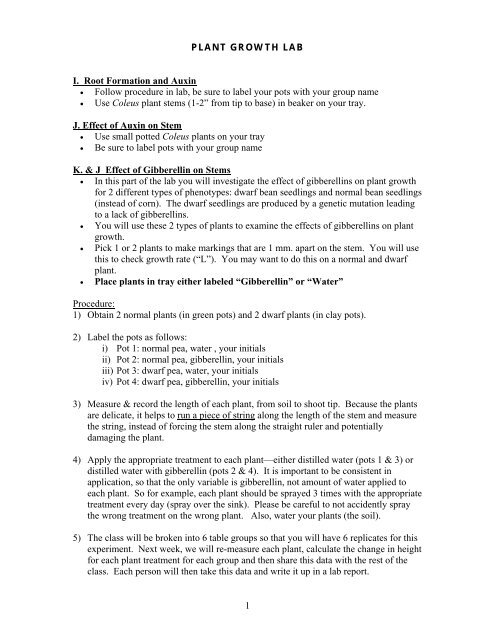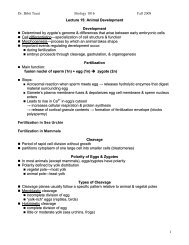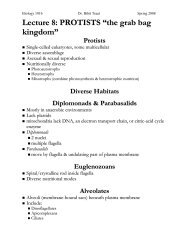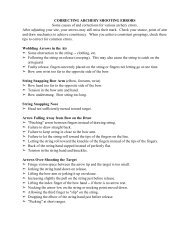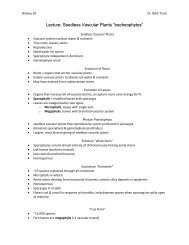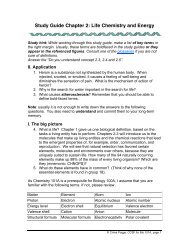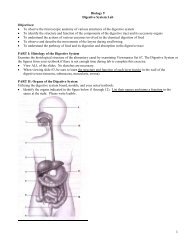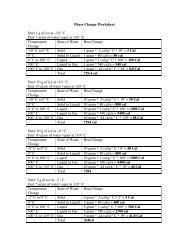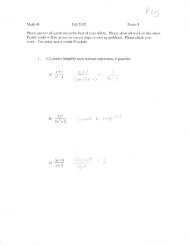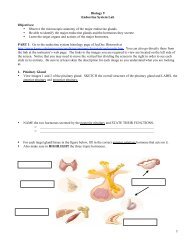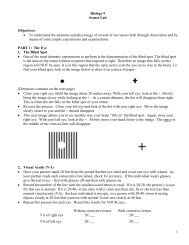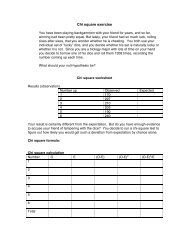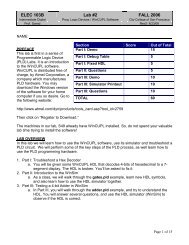PLANT GROWTH LAB - Fog.ccsf.edu
PLANT GROWTH LAB - Fog.ccsf.edu
PLANT GROWTH LAB - Fog.ccsf.edu
You also want an ePaper? Increase the reach of your titles
YUMPU automatically turns print PDFs into web optimized ePapers that Google loves.
<strong>PLANT</strong> <strong>GROWTH</strong> <strong>LAB</strong><br />
I. Root Formation and Auxin<br />
• Follow proc<strong>edu</strong>re in lab, be sure to label your pots with your group name<br />
• Use Coleus plant stems (1-2” from tip to base) in beaker on your tray.<br />
J. Effect of Auxin on Stem<br />
• Use small potted Coleus plants on your tray<br />
• Be sure to label pots with your group name<br />
K. & J Effect of Gibberellin on Stems<br />
• In this part of the lab you will investigate the effect of gibberellins on plant growth<br />
for 2 different types of phenotypes: dwarf bean seedlings and normal bean seedlings<br />
(instead of corn). The dwarf seedlings are produced by a genetic mutation leading<br />
to a lack of gibberellins.<br />
• You will use these 2 types of plants to examine the effects of gibberellins on plant<br />
growth.<br />
• Pick 1 or 2 plants to make markings that are 1 mm. apart on the stem. You will use<br />
this to check growth rate (“L”). You may want to do this on a normal and dwarf<br />
plant.<br />
• Place plants in tray either labeled “Gibberellin” or “Water”<br />
Proc<strong>edu</strong>re:<br />
1) Obtain 2 normal plants (in green pots) and 2 dwarf plants (in clay pots).<br />
2) Label the pots as follows:<br />
i) Pot 1: normal pea, water , your initials<br />
ii) Pot 2: normal pea, gibberellin, your initials<br />
iii) Pot 3: dwarf pea, water, your initials<br />
iv) Pot 4: dwarf pea, gibberellin, your initials<br />
3) Measure & record the length of each plant, from soil to shoot tip. Because the plants<br />
are delicate, it helps to run a piece of string along the length of the stem and measure<br />
the string, instead of forcing the stem along the straight ruler and potentially<br />
damaging the plant.<br />
4) Apply the appropriate treatment to each plant—either distilled water (pots 1 & 3) or<br />
distilled water with gibberellin (pots 2 & 4). It is important to be consistent in<br />
application, so that the only variable is gibberellin, not amount of water applied to<br />
each plant. So for example, each plant should be sprayed 3 times with the appropriate<br />
treatment every day (spray over the sink). Please be careful to not accidently spray<br />
the wrong treatment on the wrong plant. Also, water your plants (the soil).<br />
5) The class will be broken into 6 table groups so that you will have 6 replicates for this<br />
experiment. Next week, we will re-measure each plant, calculate the change in height<br />
for each plant treatment for each group and then share this data with the rest of the<br />
class. Each person will then take this data and write it up in a lab report.<br />
1
6) For lab report:<br />
i) Include all of the components of a lab report (introduction, methods, results,<br />
discussion, and references). You will want to consider how to present the data<br />
(e.g. tables, bar graphs…) and how to analyze it (e.g. compare mean<br />
difference in growth between treatments, controls…..).<br />
ii) Lab report due for each person: see sch<strong>edu</strong>le<br />
M. Terminal Bud Effect on Growth<br />
• Will make demo for whole class to observe.<br />
N. Phototropism—skip<br />
O. Gravitropism<br />
• Observe example demonstration<br />
P. Etiolation<br />
• Observe example demonstration<br />
2


